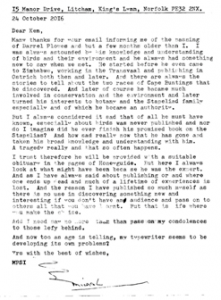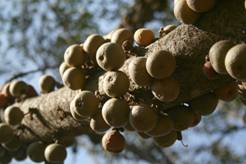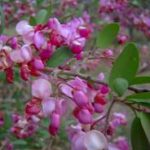TREE LIFE
December 2016
The Tree Society Committee would like to wish all members a very Happy Christmas and a prosperous, tree-filled New Year.
MASHONALAND CALENDAR
Sunday Dec 4th: Christmas Social at Val d’Or, Ruwa: Our venue again this year is Bill Clarke’s property, Val d’Or. Thanks go to Bill and Fiona for agreeing to host us.
PROGRAMME
9.30am to 10.15am Tea
10.15am Scavenger Hunt briefing
10.30am to 11.30am Team Tree Scavenger Hunt
11.30am to 11.45am Scavenger Hunt checking
12.00 to 1.00pm General Knowledge Team Quiz
1.00pm Lunch & Social
Please bring some Christmas fare to share for tea and bring your own lunch and a wine glass. The Society will provide some wine for those attending. Please bring any other drinks you may like, together with appropriate glasses. Chairs and tables will be provided.
There will be no other outings in December.
OBITUARY DARREL CHARLES HERBERT PLOWES b.4-4-1925 d.19-10-2016
To quote from Bart Wursten’s Introduction to Flora of Zimbabwe; “One of the greatest all-round naturalists of Zimbabwe, Darrel Plowes can perhaps be considered second only to Charles Swynnerton.” Sadly this icon of the stapeliophiles, orchidophiles, ornithologists and many other groups of nature lovers passed away on Wednesday, 19th October 2016 in Mutare at the age of 91. A very long innings, admittedly, but one that was not complete: up until the end Darrel was working on various projects including an updated version of information on research on stapeliads and he had plans for further research.
In the course of his long career the suffix ‘plowesii’ was applied to grasses, plants, a bird, a butterfly, a legless lizard and a mole-rat, illustrating the broad range of his interests. He was an avid collector and photographer whose specimens can be seen at the National Herbarium and whose photos have appeared in so many books and magazines like National Geographic. Also to be mentioned is his collection of birds’ eggs, one of the largest in Zimbabwe, which was donated to the National Museum.
South African by birth, after completing school and serving in the forces in Italy in World War II Darrel graduated in agriculture, soil conservation and ecology from Witwatersrand University where he was a founder member of the Ornithological Society. He moved to Southern Rhodesia in 1949 to take up a post at Matopos Research Station. In 1956 he was appointed Provincial Agricultural Officer, Manicaland. From 1982-1995, following his wife who worked for USAID, he lived in Botswana, Sudan, Washington D.C. and Chad. Since that date he has been ‘retired’ in Mutare.

Letter from Michael Irwin
Darrel’s idea of ‘retirement’ was to spend all of every day and much of the night pursuing his photography, writing, research and field work. When I got to know him in ’95 he was already well known for his ‘Wild Flowers of Rhodesia’, written in cooperation with Bob Drummond and had begun to write the definitive work on Stapeliads. Darrel always welcomed visitors and, after showing them his latest orchid acquisitions sent from all over the world and lovingly planted and nourished, he would immediately involve them in his latest thoughts on everything from birds in the garden to recent political developments. His office was a hive of activity with the latest IT equipment, newly arrived books and journals on any natural history topic and cabinets of slides which he would send all over the world when requested. Despite all this activity, Darrel would leave his desk and come to chat with us over a cup of tea or a beer keeping up with local and family news. Occasionally he would accompany the local group on birding outings, giving us the benefit of his compendial knowledge. He also acceded to requests from Mutare or Harare to give an illustrated talk on whatever was needed. And not only the birders benefited: I have seen him holding forth to the Orchid Society at Mukuvisi on many occasions.
Locally, Darrel supported those planning to upgrade Mutare Museum and more recently La Rochelle’s new orchid exhibition, and this in his late 80s.
Zimbabwe has many reasons to mourn the passing of this larger than life naturalist. Thank you for all you have done for us, Darrel. Rest in Peace.
– Ken Dixon
No PLANTED TREES OF HARARE for this month, hopefully we will have one for January
– Ed.
OUTING TO HUMANI SEPT 2016 (CONT’D) Turgwe Day 3 (with some divergence)
This day started off with eight intrepid tree members breaking rank and going on a black rhino tracking exercise. A rare privilege that is maybe disappearing faster than we would wish. Trees would just have to wait a few hours! Unfortunately the wind was blowing quite strongly and always in the wrong direction to give us a good chance of catching up with the pair of black rhino we were tracking, however we did get a fleeting view of one of the pair. As a fine mist of rain had fallen during the early morning hours tracking was comparatively easy even for us myopics! Another good set of tracks encountered that morning was of a sizable fresh python spoor and a very fresh set of leopard tracts, and the vervet monkeys to our right were actually watching the leopard judging by their alarm calls while we tried to get upwind of the rhino!
We felt we might partially exonerate ourselves with the dendrophiles by seeing a new species for our list viz Ximenia caffra with its hairy leaves. Ximenia americana has smooth blue green leaves and is quite common in the conservancy.
After our exercise on foot we returned for breakfast on the Turgwe bank and then headed out to Gumani Hill, close to the ranch’s headquarters. Three houses with watered lawns gave us a slightly better chance of seeing the odd tree in early artificial leaf flush. Terminalia prunioides in fruit was evident in the garden of the house where I was staying, as not all of us were able to stay in the photography camp on the Turgwe. This tree when in flower is particularly interesting as the flowers emit a smell a bit like rotting meat, so one can be confused into thinking that predators have made a kill near by when in fact it is this tree in flower!
Gumani Hill is Commiphora habitat and as these trees were still leafless they brought out the “stem slashers” (Meg’s nemesis?) and the SWAG-ers (scientific wild ass guessers – me ?!) Fortunately a single specimen of Commiphora tenuipetiolata was in leaf in a watered garden. It has a blue green stem a bit like C. caerulea which however is only found along the Zambezi Valley. As the name implies this species has a long petiole but its common name of satin-bark corkwood seemed to maybe apply to young specimens only. However the outer skin of Commiphora, just like that of humans, can be quite variable in its diagnostic value. In some cases like C. viminae (the Zebra-barked Corkwood which I was surprised not to find on our entire outing) may have these diagnostic clues but there can be considerable overlap. Another easy to identify leafless Commiphora (only after we got our eye attuned to its characteristics) was C. edulis (Rough-leaved Corkwood) with its white-grey bark and thick smooth branches that gives the appearance of a tree below and above a compressed scrambler draped heavily on itself. Ant Kashula subsequently has told me that he is using this species of dry wood to get a fire going by using the plant as both the base and the rubbing stick and with the help of a boot lace has a smoking coal in under 15 seconds! Here it was very much a rocky hill-side plant whereas on our last trip to Malilangwe (also in the SE Lowveld) it grew on the terraces above the Chiredzi river.
Sterculia rogersii was in flower and at early fruiting stage too. The timing of this botanical trip impressed me a lot as, admittedly at first glance when we were visiting a lot of the bush was still in its rest period, however a significant number of species were starting to respond with flower and fruit to a new season of hopefully good rains.
Albizia forbesii (Broad Pod Albizia) was also evident on the hill. Its slightly pointed leaflet tip made me want to call it an odd looking A. harveyi but the latter has a more distinctive upturned and pointed end to the leaflet. Eyes for looking but not for seeing! To date we had seen A. tanganyicensis in flower on the hills in the northern section of the Savi Valley Conservancy and around the Turgwe we had encountered A. anthelmintica that was already over the flowering stage and in new green pod. Albizia versicolor was particularly eye catching (growing on the banks of the Msaize river) as the tree looked like a misplaced August Msasa tree from the eastern highlands from a distance, because of its profusion of new red pod with a narrow green rim at this time of year.
Probably the finest tree of the day was a Ficus sansibarica growing as a strangler on a Baobab with its main stems densely clad in fruit about 4cm in diameter coming off small lateral branchlets off the main stems. My planted specimen at work in Borrowdale is also in fruit the same time of year (August & September) however it has its first crop of fruit each year occurring in January & February.
On the subject of epiphytes on Baobabs, anyone going to Mana Pools should look at the very first road verge Baobab on the left hand side (North) of the road after leaving the initial boom gate on the tar road. It contains a Ficus abutilifolia as an epiphyte and I suspect it to have its roots running down a hollow centre. However in the late dry season when both host and passenger are leafless this tree is hard to notice.

Ficus sansibarica in fruit (photo Mark Hyde)
And on the subject of Ficus sansibarica, at the Domboshawa rock museum site a Ficus sansibarica has been planted in their gardens to the left hand side when looking at the granite hill side. This tree was seen in flower / fruit in May one year Fruit bats carry the fruit off to eat some distance away from the parent tree thus improving its chances of spreading to new sites. My tree at work has Phoenix reclinata seedlings growing below it thanks to bats bringing these seeds from a plant about 100 meters away.
The rest of this pleasant spring afternoon was spent walking upstream along the banks of the Turgwe. Here we found Ficus capreifolia, which is a strongly riverine verge species of fig with rough sandpapery leaves
Thanks to Mary for planning and organising this superb trip and to Mark and Meg for adding guidance, expertise and as usual the “cerebral horsepower” to this outing which makes Tree Society meetings so enlightening and informative.
– Karl van Laeren
OUTING TO IMIRIE GAME PARK, WEDZA Sunday 20th November 2016
As one of the 28 Tree Society members who went on this day-trip I must say that I found it thoroughly enjoyable, as did my companions Sue Bell, Zilla (my sister) and her friend Alastair. A full account of the activities is being given by others so I will confine my contribution to an incident which was both amazing and rather moving, at least to me.

Elephants at Imire
Many years ago I was one of the people involved in establishing Mukuvisi Woodlands as an educational and recreational area, and one of the biggest drawcards became, inevitably, the delightful pairs of baby orphan elephants which we acquired from time to time. One of those pairs consisted of “Runde”, the little female, and “Mukuvisi” the male, both of whom I knew extremely well from the age of around 8 or 9 months to 5 or 6 years old when they became a bit too big for the Woodlands (where I used to take people walking in the game area). Runde and Mukuvisi were therefore transferred to the Travers’ game and cattle ranch Imire near Wedza.
When we arrived at Imire on the above date and met Kate, granddaughter of Norman and Jill Travers, I asked her whether R & M were still there. She told me that Runde had gone to the Hensmans but Mukuvisi had remained and was now a wonderful 36-year old bull whom we would see at lunch time. At about one-thirty therefore, when we had all returned to the rocky picnic site by the dam and settled down to a delicious lunch under the trees, three elephants were brought along by their minder to be fed handfuls of tasty cubes by the children and anyone else who cared to do so. The biggest and handsomest one, with very fine slightly inward-curving tusks, I was told was Mukuvisi (whom they now called Mack); then there was his buddy, almost as big but with not such good tusks, and a small 25-year old female with tiny tusks.

Dave Hartung with elephant trunk on his back
Mukuvisi lay his huge trunk upside-down on the rock close to where I was sitting, with the ‘lips’ open to receive the ‘sweeties’; when his top lip was stroked he closed them and popped the contents into his mouth, then returned promptly for more. I took a few photos but did not feed him, and noticed that he appeared to be eyeing me; so I spoke to him quite quietly, saying “Hallo Mukuvisi, do you remember me?”, at which he immediately abandoned his feeders and grasped me lightly by the shoulder, as if to say “Hallo old friend, long time no see, eh?” (as you will observe in one of the attached photos, taken by Sue Bell). He then started to pull gently at the back of my shirt (making a bit of a mess on it in the process!), in a sort of stroking motion. His keeper was a bit worried and told him to stop (which he did straight away), but I said “No, no, it’s alright, he’s just greeting me”. We hadn’t seen each other for something like 30 years!
I believe many of the people there must have been quite astonished to witness this clear proof of the elephant’s long memory which we have all read about, but for me it was pure magic.
– Dave Hartung
Botanic Garden Walk 5th November 2016
This was a well attended meeting and the cherry on the top was that Tom Muller was with us.
For me it was a terrible morning as my car battery was flat and I had to get a new battery before I could join the group at the end of the walk. So I asked Bilal to make a note of the species discussed on the walk and the following is his contribution. Please note that many of the trees discussed are not indigenous to Zimbabwe but were planted by Tom.
Thank you to Bilal for making the notes.
“Herewith an exciting list of species encountered on Saturday morning. Please note that some of the species were unknown but their Genus was quite obvious. The ones with an sp. and a question mark denote the mystery species.
Xeroderris stuhlmannii
Milicia excelsa
Pandanus utilis, the Common Screw Pine is, despite its name, is a monocot, not a pine.
Pandanus livingstonianus, a dioecious tree, popularly known as Screw Pine
Podocarpus latifolius
Podocarpus falcatus
A very special unknown Grewia sp? with a huge synonymous cross berry
Dracaena draco – Dragon tree
Philenoptera sp?
Cassia sp?
Pterocarpus, an American species, we did find some seeds, winged completely around, very characteristic, Weeping Hearts?
Bombax ceiba, commonly known as red cotton tree
Fernandoa magnifica
Albizia schimperi
Kigelia africana
Calodendrum capense, Cape Chestnut
Ceiba speciosa, silk floss tree
Ceiba insignis, white silk floss tree
Ficus lyrata, F. chirindensis, F. benjamina, F. elastica, F. zanzibarica, F. religiosa,
F. ingens, which was planted between two rocks and now has its roots firmly going round and clasping the rocks as though it’s a single piece of stone.
And there was also another mystery fig with red fruit.
Cordia abyssinica
Bivinia jalbertii, this tree is only found in the Nyoni Hills.
Strychnos henningsii, a very special Strychnos
Podocarpus nagi, the sacred Nagi Tree of Kumano Hayatama, also called the broad leafed Podocarpus, and equally special to me, a Japanese Yellowwood, the branches broken for inspection I hope will root.
On our way back, we noticed the middle of the three Erythrina livingstonias had rotted and collapsed.”
Thank you to Tom for joining us and giving us a reminder of your great knowledge and enthusiasm – don’t be away too long.
– Bilal Khatri and Mary L.
Here is another write-up from a Botanical Garden walk done 26 years ago! Thanks to Mary for retyping it. – Ed
BOTANIC GARDEN WALL 1ST DECEMBER 1981
On December 1st Mr. Tom Muller of the National Botanic Gardens showed Tree Society members some of the rare trees in Zimbabwe, which he has successfully planted and are now growing well.
The first was Warburgia salutaris (CANELLACEAE) is so highly valued for its medicinal properties that it is virtually extinct in Zimbabwe. It was, or still is, being sold in the Harare markets at a considerable price for just the bark. By Sherlock Holmes methods it was traced back to its growth source “somewhere in the Eastern Districts” where great logs lay, stripped of their bark. The only sign of life appeared to be some coppice growing from the cut trunks but, from this, healthy young trees now grow.
There was a Strychnos henningsii with tough leaves characteristically 3-veined from the base; this, a member of LOGANIACEAE, has a deep orange slash and occurs in the Nyoni Hills in the Rusitu area of south Chimanimani.
Next was a well grown Bivinia jalbertii, FLACOURTIACEAE, also known only from the Nyoni Hills (which get the south-east moist winds and guti), known locally as Mutuputupey and greatly valued for building as the stem is absolutely straight and borer-proof. A successful plantation has been established in Chiredzi because it is almost extinct from over cutting.
Oreobambos buchwaldii, POACEAE alias GRAMINEAE, grows in the Garden Forest area as a many stemmed bush resembling bamboo only known in Zimbabwe on Mount Bukwa. There is a half acre of it in one area in the Northern Transvaal and it is in a few areas north of the Zambezi. No flowering has been recorded here.
Androstachys johnsonii, Musimbiti, one of the Ironwoods, is a member of EUPHORBIACEAE but most unusual in that family as it has opposite instead of alternate leaves; they are beautiful, like a wide ace of spades, thickly white-felted below and held up on a petiole,i.e. peltate. It occurs in south-east Zimbabwe and also in the Kruger National Park. It can be a big tree, is borer-proof and lasts for years as posts, etc.
Then there was the Screw-pine, Pandanus livingstonianus, rather palm like when adult but belonging to the family PANDANACEAE. In the botanic garden it is at present a bush but later a leader will emerge, the other stems die off and the erect stem will eventually be supported by stilt roots. This is known from the Msapa Gap in the Chimanimani Mountains.
We were shown a real palm, the fan-leaved Borassus aethiopum, ARECACEAE, very rare here, found only in the Eastern Districts but plentiful in Kenya on the Coastal belt, where it supplies an edible fruit almost as large as a football, leaves for mat-making and baskets, and the best African palm wine. It grows slowly, up to 80 feet; at about 50 years old it flowers in heads up to 8 feet high and at the same time the stem develops a swelling in the centre.
By 1800 hours the rain threatened but we saw two rare APOCYNACEAE; Voacanga schweinfurthii from just over our border with Mozambique and Funtumia africana, covered profusely with quite large pale yellow flowers with sharply cut petals, from just this side of the Chipinge border with Mozambique. Members of this family usually have profuse white latex, glossy green, ex-stipulate, opposite or whorled leaves, e.g. Frangipani, and is often poisonous.
There were others too, but the rain came and we fled. A most interesting afternoon.
– Gill Masterson
TONY ALEGRIA CHAIRMAN



